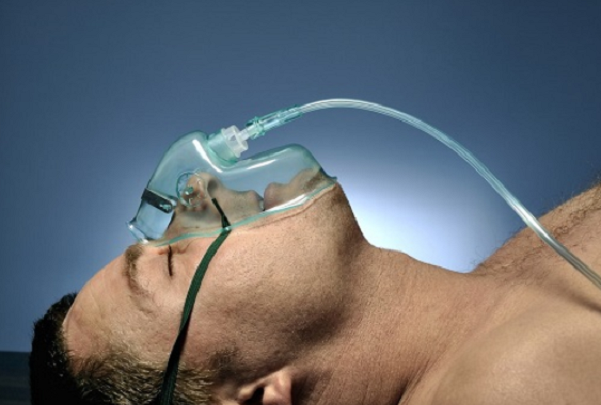Dealing with anaphylactic shock
The article is professionally consulted by MSc Tong Van Hoan - Emergency Department - Vinmec International General Hospital Da Nang.
Anaphylaxis is a generalized acute reaction, this is a serious condition that requires prompt treatment and emergency care, otherwise it can be life-threatening. In case of needing respiratory support, infusion of Adrenalin, Glucagon, need to be admitted to the emergency department.
1. First aid for anaphylaxis
The principle when giving first aid for anaphylaxis is to urgently perform CPR on the spot until the airway (Airway), breathing (Breathing), circulation (Circulation) with adrenaline, transmission... and then transferred to another place.
Immediately stop exposure to allergens such as drugs, blood and blood products, infusion fluids, oral, topical, eye drops...
1.1. General treatment At mild level, it is possible to use antihistamines subcutaneously or Methylprednisolone 40-80mg intravenously.
In severe cases, if there is difficulty breathing or low blood pressure, the patient should be placed in the position, with the head low, the legs high. Administer adrenaline 0.5-1mg ampoule intramuscularly into the anterolateral side of the thigh.
For children, dilute 1 ampoule of adrenaline with 10ml of distilled water for intramuscular injection 0.01mg/kg/time. Inject every 10-15 minutes until the radial pulse becomes clear, blood pressure returns to normal, shortness of breath completely decreases.
If there is no radial pulse after 1mg/5 minutes, continue injecting adrenaline 0.3-0.5mg/time/every 5 minutes through the femoral vein or jugular vein until the pulse is captured, then switch to continuous intravenous infusion.
1.2. Specialized treatment Respiratory treatment needs to ensure that the airways are open, oxygen is given through glasses or a mask. Can emergency tracheostomy if there is glottis edema, squeeze ambu balloon with oxygen, ventilator with 100% oxygen in the first hour, adjust ventilator according to specific condition.

Sốc phản vệ cần được điều trị hô hấp
Circulatory therapy includes
Insertion of an intravenous line (peripheral vein), if this cannot be established, a central line is inserted through the jugular vein or the femoral vein.
Rapid infusion of sodium chloride 0.9% 1-2 liters, can be combined with colloidal solution or Haesteril 6%, because anaphylaxis always has vasodilation associated with increased vascular permeability.
Continuous intravenous infusion of adrenaline starting at 0.1 μg/kg and then titrated so that systolic blood pressure > 90 mmHg.
Emergency cardiopulmonary arrest due to anaphylaxis Need to handle according to basic or intensive cardiopulmonary arrest emergency protocol.
2. Monitoring and treatment after emergency anaphylaxis
Some other treatment can be used to treat anaphylaxis such as:
Methylprednisolone intravenously 1mg/kg/4 hours or intravenous hydrocortisone hemisuccinate 5mg/kg/4 hours. Salbutamol or ventolin by throat spray or aerosol if there is difficulty breathing, can be added to aminophyline intravenous bolus. Antihistamine: intramuscular prometazin 0.5-1mg. + Antihistamine H1: usually use Diphenhydramine 1-2 mg/kg or promethazine (Pypolphen) 0.5-1mg/kg every 6-8 hours.
+ Antihistamine H2: Ranitidine: 1-2 mg/kg.
Combination of H1&H2 antagonists is more effective than H1 antagonists alone in the treatment of anaphylactic skin manifestations. Take activated charcoal and laxatives if the allergen is ingested. Compression bandages above the injection site or venom entry if present. After emergency anaphylaxis, the patient should be monitored for:
Biphasic anaphylaxis: may appear 1 - 72 hours after the initial response. 5-20% of cases have biphasic anaphylaxis, about 3% need emergency treatment. The risk is biphasic: injection of adrenaline with a larger initial dose. Post-emergency follow-up should be done within the first 4-6 hours, paying special attention to the first 72 hours. Cases at risk of biphasic need to be hospitalized for monitoring. In case of needing respiratory support, infusion of Adrenalin, Glucagon, need to be admitted to the emergency department.

Cẩn thận Sốc phản vệ 2 pha
3. Why is adrenaline often used in the emergency of anaphylaxis?
The specific emergency and treatment regimen for anaphylaxis may vary depending on the qualifications and skills of the physician and the condition of the equipment. In particular, intramuscular adrenaline is still the basic treatment with life-saving properties.
Therefore, adrenaline needs to be prepared in advance for all situations where there is a risk of anaphylaxis such as infusion, drug infusion, anesthetic anesthesia, contact with bees...
Regarding the mechanism, adrenaline Acting on sympathetic nerve receptors helps to resolve most symptoms of anaphylaxis, e.g. vasoconstrictor effects (helps to raise blood pressure, reduces edema, erythema), increases myocardial contractility, dilates bronchial smooth muscle...
Studies have shown that the earlier adrenaline is administered in anaphylaxis, the more effective it is, most of the anaphylaxis emergencies fail due to slow adrenaline administration.

Adrenaline thường được dùng để cấp cứu sốc phản vệ
However, like other drugs, adrenaline can also cause many unwanted effects, especially when administered intravenously, most commonly tremors, chest pain, tachycardia. ...
Several cases of myocardial infarction have been associated with the intravenous administration of adrenaline in the treatment of anaphylaxis, although anaphylaxis itself can also cause this complication.
Intramuscular adrenaline is by far the safest and most effective route of administration in the treatment of anaphylaxis.
In addition to Adrenaline, Corticosteroids and antihistamines such as diphenhydramine, dimedrol should also be used and have good effect on shock symptoms in the skin and mucous membranes.
Technicians and doctors both need to understand the process and how to handle anaphylaxis. It is important that the patient is treated and treated as soon as possible.
Để đặt lịch khám tại viện, Quý khách vui lòng bấm số HOTLINE hoặc đặt lịch trực tiếp TẠI ĐÂY. Tải và đặt lịch khám tự động trên ứng dụng MyVinmec để quản lý, theo dõi lịch và đặt hẹn mọi lúc mọi nơi ngay trên ứng dụng.






